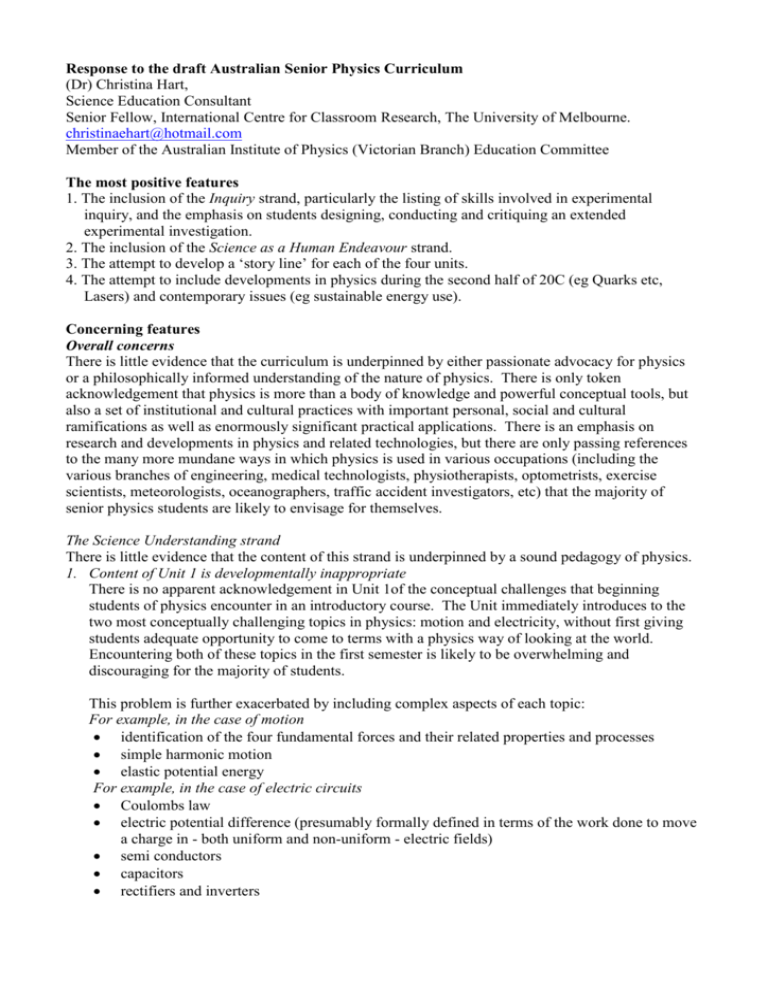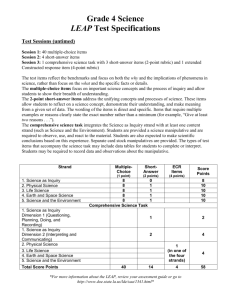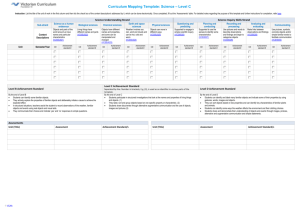Response to Physics Draft by Dr Christina Hart
advertisement

Response to the draft Australian Senior Physics Curriculum (Dr) Christina Hart, Science Education Consultant Senior Fellow, International Centre for Classroom Research, The University of Melbourne. christinaehart@hotmail.com Member of the Australian Institute of Physics (Victorian Branch) Education Committee The most positive features 1. The inclusion of the Inquiry strand, particularly the listing of skills involved in experimental inquiry, and the emphasis on students designing, conducting and critiquing an extended experimental investigation. 2. The inclusion of the Science as a Human Endeavour strand. 3. The attempt to develop a ‘story line’ for each of the four units. 4. The attempt to include developments in physics during the second half of 20C (eg Quarks etc, Lasers) and contemporary issues (eg sustainable energy use). Concerning features Overall concerns There is little evidence that the curriculum is underpinned by either passionate advocacy for physics or a philosophically informed understanding of the nature of physics. There is only token acknowledgement that physics is more than a body of knowledge and powerful conceptual tools, but also a set of institutional and cultural practices with important personal, social and cultural ramifications as well as enormously significant practical applications. There is an emphasis on research and developments in physics and related technologies, but there are only passing references to the many more mundane ways in which physics is used in various occupations (including the various branches of engineering, medical technologists, physiotherapists, optometrists, exercise scientists, meteorologists, oceanographers, traffic accident investigators, etc) that the majority of senior physics students are likely to envisage for themselves. The Science Understanding strand There is little evidence that the content of this strand is underpinned by a sound pedagogy of physics. 1. Content of Unit 1 is developmentally inappropriate There is no apparent acknowledgement in Unit 1of the conceptual challenges that beginning students of physics encounter in an introductory course. The Unit immediately introduces to the two most conceptually challenging topics in physics: motion and electricity, without first giving students adequate opportunity to come to terms with a physics way of looking at the world. Encountering both of these topics in the first semester is likely to be overwhelming and discouraging for the majority of students. This problem is further exacerbated by including complex aspects of each topic: For example, in the case of motion identification of the four fundamental forces and their related properties and processes simple harmonic motion elastic potential energy For example, in the case of electric circuits Coulombs law electric potential difference (presumably formally defined in terms of the work done to move a charge in - both uniform and non-uniform - electric fields) semi conductors capacitors rectifiers and inverters 2. Content of other units is developmentally inappropriate and/or inappropriately sequenced For example: wave motion is introduced in Unit 2 in the context of light and electromagnetic waves. Yet light is an abstract example of wave motion, and electromagnetic waves, even more so for students who have not yet encountered electromagnetic interactions. Interpreting phenomena such as interference, diffraction and resonance for light and em radiation can only make sense if these phenomena have been experienced in relation to mechanical waves, including sound, whose wave characteristics are more readily perceived. If students haven’t previously encountered these behaviours in situations where they can be clearly seen as wave phenomena, they cannot interpret their occurrence as evidence for the wave-like character of light and em radiation, and they will have great difficulty seeing the phenomena at all. Some content cannot be addressed in any meaningful way at the stage specified. For example: Maxwell’s prediction of the existence of electromagnetic waves Hertz’s experimental validation of Maxwell’s electromagnetic wave prediction.” (Unit 2, p 10) the greenhouse effect as a consequence of the resonance frequencies of molecules in Earth’s atmosphere.”(Unit 2, p 10) Some content is simply too complex to be addressed at the stage specified. For example: In unit 2 (p 11): “discovery of … the neutrino” and “the application of the laws of momentum and energy in the analysis of data from accelerators such as those at Fermilab and the Large Hadron Collider.” 3. Content is overloaded For example: In unit 2 (p 11): The section on nuclear physics covers nearly twice as much material as the corresponding section of the VCE Physics course where it is allotted approximately 1/3 of a semester. In unit 2 (p 11): The section “dependence of theories about the universe on information obtained using the electromagnetic spectrum” appears to amount to a further 1/3+ of a semester. 4. The content is not conceptually coherent For example: Unit 1 p 6 energy conservation in a range of It is not clear how these are conceptually related situations (for example, individual to the preceding living organisms, ecosystems, the mechanics concepts. energy balance of Earth) the spatial distribution of solar radiation and the resulting large-scale circulation of the atmosphere and oceans. The story line of unit the roles of terrestrial and two is not clear, but extraterrestrial telescopes, and the whatever it is, these dot types of radiation collected the Big Bang theory and the evidence points don’t seem to be part of it. that supports the theory, including galactic red shift and cosmic background radiation. In some cases, content crucial for understanding other concepts is absent. For example: In unit 2 (p 10): the wave equation (v = f λ) is not specified, but is necessary for understanding most of the content related to waves. In unit 2 (p 11): Meaningful discussion of biohazards in connection with the uses of radio isotopes requires knowledge of ‘dose’ and ‘dose equivalent’ 5. Some content is defined in vague and/or confused terms For example: “identification of the four fundamental forces and their related properties and processes” “the generation of contact forces and frictional forces from electrical interactions”; “the description of a system in equilibrium” 6. Content consists of concepts that are sometimes incommensurate in terms of their importance and complexity For example, compare: Unit 1. p 6 “the interpretation of observations of “the difference between everyday motion using Newton’ three mass and weight” laws of motion” The Science as a Human Endeavour strand This is the most disappointing of the three strands in the proposed curriculum. As presently structured it reads as a list of interesting anecdotes that teachers might recount if they are informed and so inclined. There is little sense of how this might be integrated in a meaningful way with the Science Understanding strand, and consequently an expectation that it would be disregarded in any proposed assessment. Many of the applications listed are rather tenuously related to the content of the Science Understanding strand, and require considerably more sophisticated knowledge for genuine understanding; again this means that they are unlikely to be picked up in assessment in any meaningful way. There are many references to historical developments and the contributions of individual physicists, but this conveys a naïve view of the history of science and a misleading view of the way that contemporary physics advances. An acknowledgement of the team work that is the hall mark of physics today would provide a more meaningful way of including female contributions than token mentions of female contributions to the history of physics. There is greater emphasis on research and new developments than on the many ways in which existing physics knowledge is applied in a range of occupations. The Inquiry strand: This strand clearly includes the intention of developing students skills in experimental inquiry, and the listing of the skills involved is extensive and appropriate. I strongly support the intention that students will carry out genuine extended experimental investigations. Such investigations have been a part of the VCE Physics course since before 1991, and are highly regarded by both teachers and students as one of the most worthwhile aspects of the Physic course. There are also well-developed assessment strategies capable of supporting the intention of genuine experimental inquiry. However, many of the activities listed under the inquiry strand do not appear to involve genuine inquiry. They generally would form an important part of students’ learning of physics concepts, providing evidence for those concepts or illustrating how they may be applied. For the most part, these activities do not involve students in designing, conducting and critiquing an experimental inquiry. Problems with this strand raise at least three interconnected issues that need to be resolved. i) What is the role of ‘demonstration’ type activities (whether teacher or student conducted) in students’ learning, and how – or whether – this should be specified in the curriculum or, more significantly, assessment? ii) What is meant by ‘experimental inquiry’, and what distinguishes such inquiry from the ‘demonstration’ type activities? iii) Is ‘experimental inquiry’ the only kind of worthwhile inquiry for students to engage in? The wording of some dots points under the inquiry strand implies that a different kind of inquiry, a more ‘conceptual/issues’ inquiry that draws on secondary sources of information, is envisaged without being made explicit. For example the following skills are more likely to apply to this type of inquiry than to ‘experimental inquiry: researching, selecting and synthesising relevant information from a range of sources, and referencing sources appropriately evaluating claims in advertising and the media explaining concepts and debating issues related to physics to a range of audiences. Arguably the learning from such ‘conceptual/issues’ inquiries are one of the most important outcomes for students studying a senior physics course, especially the majority who will not go on to a post-secondary physics course. iv) Is it feasible to conduct one extended experimental investigation in each semester if genuine inquiry is to be fostered? If there is too strong an emphasis on ‘experimental inquiry’ will this be at the cost of developing other skill, perhaps more readily developed through the kind of ‘conceptual/issues’ inquiry implied in iii) above. Some further comments The attempt to develop a single story line is a very good idea in principle, but doesn’t really work across a whole semester. A more helpful structure might be developed from two (or at most three) unrelated, but internally tight and coherent story lines in each semester. The attempt to include, in the Science Understanding strand, developments in physics during the second half of 20C might have more chance of success if supportive paradigms for assessment were implied. (I realise that the National Curriculum does not intend to prescribe assessment, but the way content is presented necessarily implies certain forms of assessment and precludes some possibilities). Presenting the content of the Science Understanding strand as a list of discrete dot points implies a reductionist view of physics knowledge and a corresponding paradigm of exambased assessment, where the separate dot points are each tested by discrete questions. Developments in physics in the later part of the 20C cannot be summarised in discrete dot points and equations that are accessible to senior secondary students. They must therefore be addressed qualitatively, and a reductionist assessment paradigm would then reduce what students are expected to know to a list of what must be recalled. This is not an acceptable outcome from a physics course. If these aspects of physics are to be valued, as I believe they should be, then the content must be specified in ways that envisage supportive assessment paradigms. Similar comments about the options envisaged for assessment apply to the Inquiry and Science as a Human Endeavour strands.





